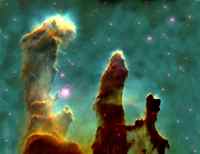Difference between revisions of "Nebula"
(Created page with 'File:lighterstill.jpgright|frame A '''nebula''' (from Latin: "cloud" [1]; pl. nebulae or nebulæ, with ligature or nebulas) is an [http:...') |
m (Text replacement - "http://" to "https://") |
||
| (One intermediate revision by one other user not shown) | |||
| Line 1: | Line 1: | ||
[[File:lighterstill.jpg]][[File:Pillars-of-creation.jpg|right|frame]] | [[File:lighterstill.jpg]][[File:Pillars-of-creation.jpg|right|frame]] | ||
| − | A '''nebula''' (from [[Latin]]: "cloud" [1]; pl. nebulae or nebulæ, with ligature or nebulas) is an [ | + | A '''nebula''' (from [[Latin]]: "cloud" [1]; pl. nebulae or nebulæ, with ligature or nebulas) is an [https://en.wikipedia.org/wiki/Interstellar_cloud interstellar cloud] of dust, hydrogen gas, helium gas and [https://en.wikipedia.org/wiki/Plasma_(physics) plasma]. Originally nebula was a general name for any extended [[astronomical]] object, including [[galaxies]] beyond the [[Milky Way]] (some examples of the older usage [[survive]]; for example, the [https://en.wikipedia.org/wiki/Andromeda_Galaxy Andromeda Galaxy] was referred to as the Andromeda Nebula before galaxies were [[discovered]] by [https://en.wikipedia.org/wiki/Edwin_Hubble Edwin Hubble]). Nebulae often form star-forming regions, such as in the [https://en.wikipedia.org/wiki/Eagle_Nebula Eagle Nebula]. This nebula is depicted in one of NASA's most famous images, the "[https://en.wikipedia.org/wiki/Pillars_of_Creation Pillars of Creation]". In these regions the formations of gas, dust and other materials "clump" together to form larger [[mass]]es, which [[attract]] further [[matter]], and [[eventually]] will become big enough to form stars. The remaining [[materials]] are then believed to form [[planets]], and other planetary [[system]] objects.[https://en.wikipedia.org/wiki/Nebula] |
[[Category: Astronomy]] | [[Category: Astronomy]] | ||
Latest revision as of 01:27, 13 December 2020
A nebula (from Latin: "cloud" [1]; pl. nebulae or nebulæ, with ligature or nebulas) is an interstellar cloud of dust, hydrogen gas, helium gas and plasma. Originally nebula was a general name for any extended astronomical object, including galaxies beyond the Milky Way (some examples of the older usage survive; for example, the Andromeda Galaxy was referred to as the Andromeda Nebula before galaxies were discovered by Edwin Hubble). Nebulae often form star-forming regions, such as in the Eagle Nebula. This nebula is depicted in one of NASA's most famous images, the "Pillars of Creation". In these regions the formations of gas, dust and other materials "clump" together to form larger masses, which attract further matter, and eventually will become big enough to form stars. The remaining materials are then believed to form planets, and other planetary system objects.[1]
